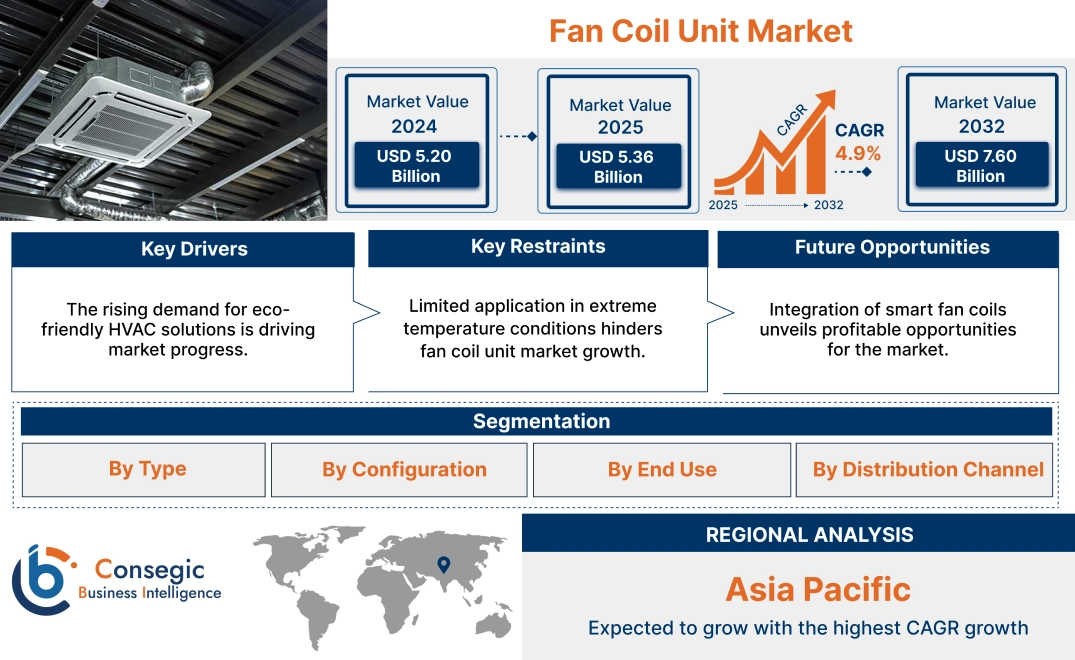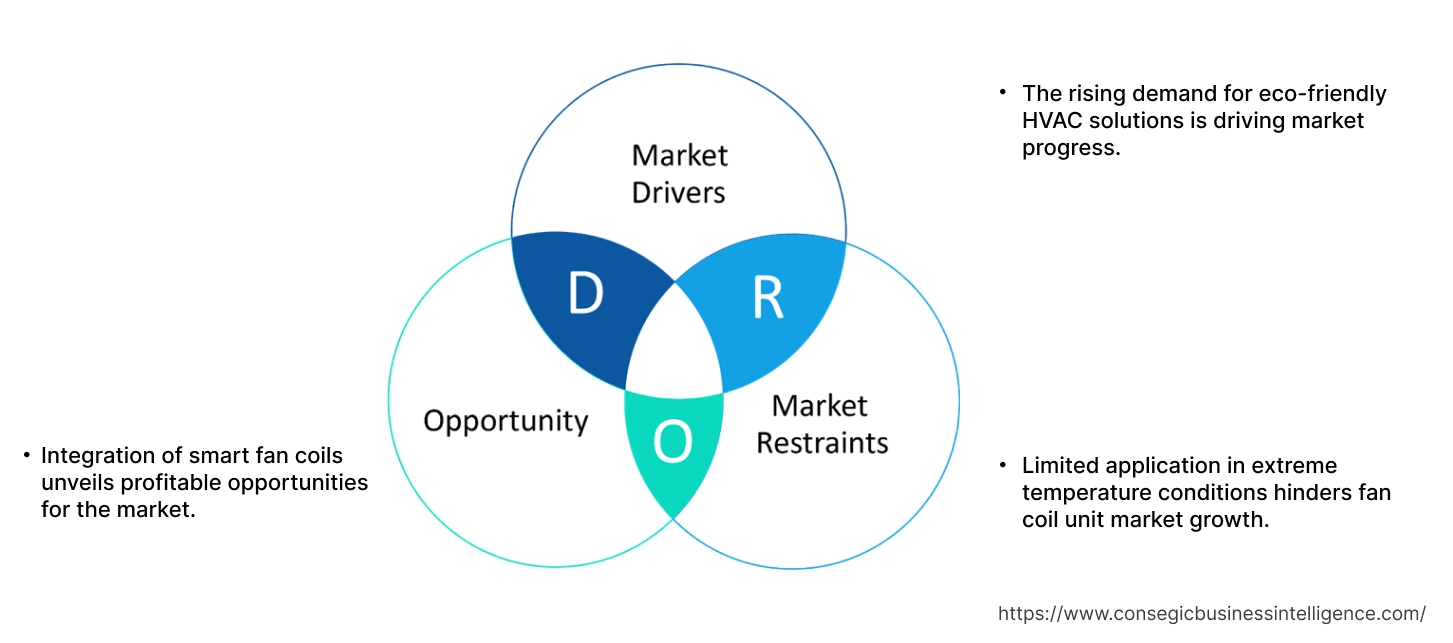- Summary
- Table Of Content
- Methodology
Fan Coil Unit Market Size:
Fan Coil Unit Market size is estimated to reach over USD 7.60 Billion by 2032 from a value of USD 5.20 Billion in 2024 and is projected to grow by USD 5.36 Billion in 2025, growing at a CAGR of 4.9% from 2025 to 2032.
Fan Coil Unit Market Scope & Overview:
A fan coil unit (FCU) is an independent heating, cooling and ventilation (HVAC) device which consists of a heat exchanger and a fan designed to provide localized heating and cooling in a space by circulating air through either hot or cold water. The internal coil receives conditioned water from a central plant or chiller system, and the integrated fan blows room air across the coil surface to either increase or decrease the ambient temperature.
These units are available in horizontal, vertical, ceiling-concealed, and floor-mounted formats, and are typically controlled via thermostats or building automation interfaces. Additionally, some models integrate filters, modulating valves, or electronically commutated motors for enhanced efficiency and control.
FCU units are employed in various settings including commercial buildings, hotels, hospitals, and high-density residential projects where zoning flexibility and decentralized operation are prioritized.
Key Drivers:
The rising demand for eco-friendly HVAC solutions is driving market progress.
The rising trend for sustainability and environmentally friendly options for fan coils is fueling the demand for advanced HVAC solutions. These coil units, known for their energy-efficient performance, play a crucial role in meeting this demand. Additionally, these units are designed to provide targeted heating and cooling for specific areas, reducing the need for centralized systems and ensuring energy is used effectively. Furthermore, these systems assist in regulating energy wastage by offering to heat or cool individual rooms, in turn reducing operational costs. This enables them to become an ideal choice for applications in residential buildings, offices and hospitality sector.
- For instance, in December 2024, Azizi Developments partnered with the Finpower Aircon to supply advanced HVAC solutions. High-tech fan coils providing energy-efficiency and optimal cooling performance will be integrated into Azizi’s Venice and Riviera properties.
Furthermore, with the reduction of carbon footprints and meeting energy conservation standards, the adoption of these units rises significantly, driving FCU market growth.
Key Restraints:
Limited application in extreme temperature conditions hinders fan coil unit market growth.
Fan coil units, despite being versatile, face difficulties when it comes to operating in regions with extreme climatic conditions. In extremely cold climates, the coil units may struggle to provide adequate heating on their own, necessitating the use of additional heating systems to achieve the desired indoor temperature, whereas, in regions of high humidity, these coil units may not deliver the required cooling efficiency, as they primarily rely on air circulation rather than dehumidification. In such conditions the need for optimized cooling systems or dehumidification systems becomes a must. Therefore, these limitations restrict the use of fan coils in certain geographic areas, hindering their adoption in these regions, impeding the global fan coil unit market growth.
Future Opportunities :
Integration of smart fan coils unveils profitable opportunities for the market.
Advances in HVAC system technologies are creating prospects for the development of advanced fan coils. These coils incorporated with cutting-edge features like variable-speed motors will allow for precise control of airflow, optimizing energy consumption by adjusting to the specific needs of a room or building. Additionally, the integration of Wi-Fi connectivity and enhanced control systems will make it easier to track usage patterns enabling users to remotely monitor and adjust settings. Furthermore, these advanced systems will provide energy efficiency, reduce costs, and improve user comfort, fueling market demand.
- For instance, in September 2024, UnaBiz announced the launch of a trio of its innovative solutions for Smart Building Sector at BEX Asia 2024. One of which being the 3-in-1 Fan Coil Unit (FCU) Monitoring packed with smart filter replacement technology, a sensitive lux sensor which accurately filters the air, and the leak sensors that monitor the FCU tray for potential overflows.
Therefore, as the adoption of advanced HVAC systems and sophisticated fan coils rises, the market will grow, driving global fan coil unit market trends.
Fan Coil Unit Market Segmental Analysis :
By Type:
Based on type, the market is categorized into horizontal FCU, vertical FCU, and cassette FCU.
The horizontal FCU hold the largest revenue share of the overall Fan Coil Unit Market in the year 2024.
- Horizontal FCUs are systems used for air conditioning that uses a fan and a coil to heat or cool air in a room. They are installed horizontally, above ceilings or against walls.
- These units are the most widely installed configuration in commercial and residential HVAC systems due to their ceiling-mount compatibility and space-saving design.
- Additionally, their modularity and ease of integration with central chilled water or heating systems make them the default choice for medium to large buildings.
- According to the market analysis, their versatility to perform across varied climate zones and ease of use, significantly drives the fan coil unit market expansion.
The cassette FCU segment is expected to grow at the fastest CAGR during the forecast period.
- Cassette FCUs are integrated into suspended ceilings and provide uniform air distribution across four directions, enhancing occupant comfort in open-plan spaces.
- Additionally, advances in technology like DC inverter motors, condensate pumps, and remote diagnostics are expanding the utility of cassette fan coils in smart building environments.
- These units are increasingly adopted in retail stores, showrooms, healthcare facilities, and modern offices due to their discreet design and efficient airflow management.
- For instance, in July 2024, Samsung India launched a new range of chilled water-based cassette units. This unit allows users to set the required temperature, assisted by their WindFree and 360o Bladeless cooling technology that slowly release cool air of up to 15,000 micro-air holes at wind speed of 0.15m/sec.
- As per the fan coil unit market analysis, the rising need for cassette ceiling fan units in buildings with space constraints is significantly fueling the fan coil unit market demand.
By Configuration:
Based on configuration, the market is categorized into two-pipe systems and four-pipe systems.
The two-pipe system segment holds the largest revenue of the overall Fan Coil Unit Market share in the year 2024.
- Two-pipe fan coil systems use a single supply and return pipe for either heating or cooling, making them cost-effective and suitable for moderate climate zones.
- These systems incur low installation costs, simple maintenance, and reduced plumbing complexity make it easier for construction projects with budget constraints to adopt two-pipe systems.
- Additionally, they are widely deployed in residential complexes, budget hotels, and small commercial buildings where seasonal switchover of functions is acceptable.
- The market analysis shows that their broad installed base and value-oriented appeal make two-pipe systems the largest market, significantly driving the fan coil unit market opportunities.
The four-pipe system segment is expected to grow at the fastest CAGR during the forecast period.
- Four-pipe fan coil systems allow simultaneous heating and cooling by providing separate supply and return lines for each function, offering superior climate control flexibility.
- Adopting these systems allows for better comfort options, and aesthetic appeal to surroundings, especially mixed-use developments and luxury infrastructure.
- Additionally, they are ideal for high-performance commercial buildings, hospitals, and hotels where different zones may require independent thermal management.
- Thus, as building design trends move toward individualized temperature control and year-round energy optimization, the four-pipe systems are gaining traction, driving the fan coil unit market opportunities.
By End-Use:
Based on End-Use, the market is categorized into residential, commercial, and industrial sectors.
The commercial segment holds the largest revenue share of the overall Fan Coil Unit Market of 49.8% in the year 2024.
- Commercial buildings including hotels, offices, educational institutions, and healthcare facilities rely heavily on fan coils for room-level temperature management.
- These spaces benefit from the flexibility, zoning capability, and cost-efficiency of coil units in both centralized and decentralized HVAC systems.
- Additionally, these coils allow reduced ductwork requirements and improved quality of air inside these settings.
- For instance, in August 2024, Keane Environmental supplied Diffusion’s Slimline Highline 170 EC/DC fan coil units with inlet attenuators to Bank Centre site in Dublin. These coil units are well suited for work environments and workspaces in Europe.
- As per the market analysis, the wide applications and significant of these HVAC systems in commercial buildings significantly drive the global fan coil unit market expansion.
The residential segment is expected to grow at the fastest CAGR during the forecast period.
- The residential sector is witnessing increased adoption of fan coil units in multi-dwelling units (MDUs), luxury apartments, and smart homes.
- Technological and infrastructural advancements make these coil units the most viable in residential layouts with space constraints.
- Additionally, growing consumer preference for individual room temperature control, low noise operation, energy-efficient indoor cooling, and the rise in green building certifications further stimulate adoption.
- For instance, in May 2023, The Diffusion Group announced the launch of its new Highline 235 modular fan coil range, developed to perfectly cater indoor environments in indoor and home settings. These coil units offer modular designs, low sound level, and reduced energy consumption.
- According to the fan coil unit market analysis, the rising demand in residential settings, advancing technologies and the increasing initiatives by governments for high-efficiency HVAC upgrades is significantly driving the fan coil unit market trends.
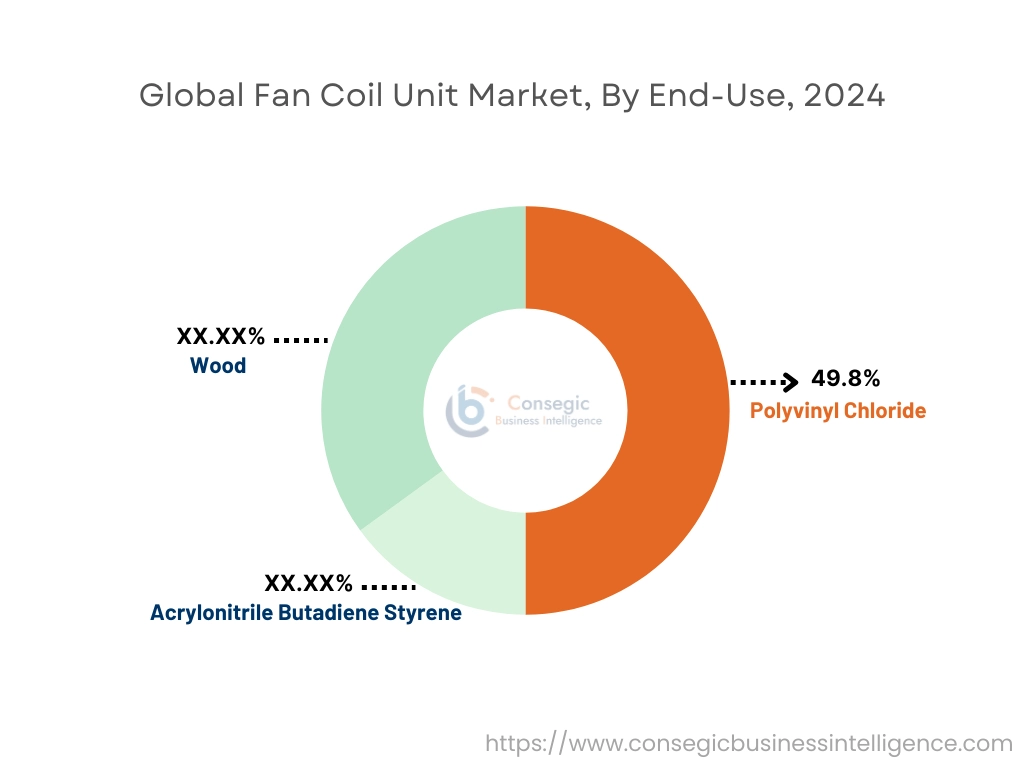
By Distribution Channel:
Based on the distribution channel, the market is categorized into direct sales, HVAC contractors, online retail, and distributors & wholesalers.
The HVAC Contractors hold the largest revenue of the overall Fan Coil Unit Market share in the year 2024.
- HVAC contractors remain the primary channel for fan coil deployment in both residential and commercial construction projects, due to their involvement from system design through installation.
- Contractors often serve as trusted decision-makers for building owners, influencing brand selection, configuration, and installation approach based on building layout and performance requirements.
- Additionally, their direct relationship with the manufacturers allows them to provide original models and customized ones to clients based on their specific needs.
- Thus, the market analysis depicts the growing advances in fan coil technology, and HVAC systems drive the HVAC contractor segment, substantially driving the FCU market.
Online Retail is expected to grow at the fastest CAGR during the forecast period.
- Online retail is emerging as the fastest-growing distribution channel, particularly for compact and standardized coil units targeted at residential and light-commercial customers.
- The easy installation by consumers themselves, rising awareness of product specifications, and a surge in online B2B procurement platforms offering HVAC equipment with logistics support.
- Additionally, the trend is further supported by quick replacement policies of online shopping platforms, making it easier to effectively replace defective or unnecessary items.
- According to the market analysis, digital transformation influencing HVAC supply chains and the growing e-commerce platforms significantly boosts the FCU market growth.
Regional Analysis:
The regions covered are North America, Europe, Asia Pacific, Middle East and Africa, and Latin America.
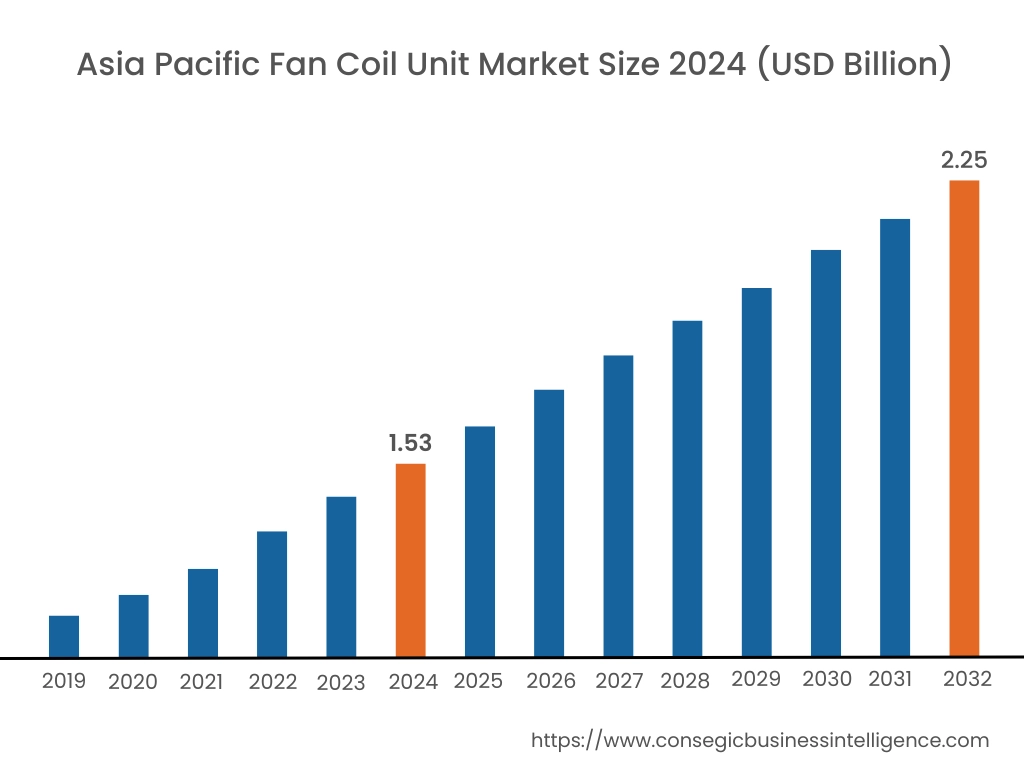
Asia Pacific region was valued at USD 1.53 Billion in 2024. Moreover, it is projected to grow by USD 1.58 Billion in 2025 and reach over USD 2.25 Billion by 2032. Out of this, China accounted for the maximum revenue share of 44.2%.
In the Asia-Pacific region, the rapid technological advances, infrastructural development and growing urbanization has led to dynamic adoption of the coil units. Additionally, the growing focus on energy efficiency, tailored solutions catering to diverse climate conditions has led to noticeable trends in this market.
- For instance, in July 2024, Trane launched the Climate Changer Magicube (CLCM) air handling unit in the Asia-Pacific region. This technology is equipped with customized fan coil units, offering economic value and saving energy by 15-30%.
Furthermore, the integration of smart features, allowing for real‑time monitoring and adaptive control of indoor environments have significantly driven the fan coil unit market demand.
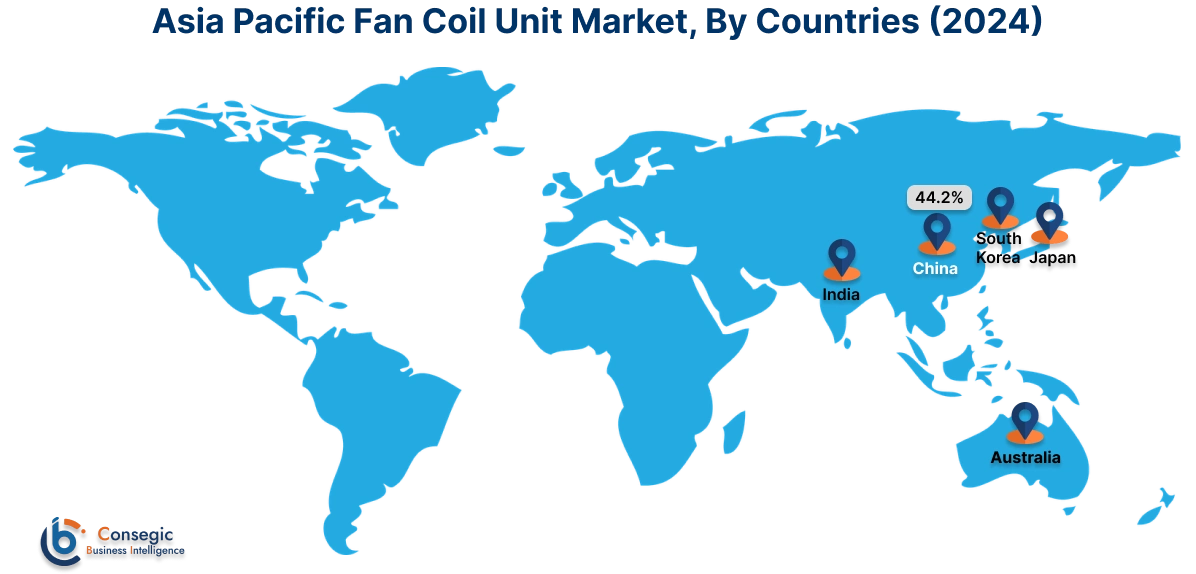
North America is estimated to reach over USD 2.07 Billion by 2032 from a value of USD 1.41 Billion in 2024 and is projected to grow by USD 1.45 Billion in 2025.
In North America, the market for fan coil units is undergoing a transformation as traditional HVAC systems are increasingly complemented by innovative technologies. Additionally, the incorporation of smart sensor technologies and the adoption of environmentally friendly materials has substantially boosted the market trend.
- For instance, in September 2024, Trane Technologies acquired Damuth Services, based in Virginia. This acquisition will continue to serve the clients’ HVAC system needs, supplying and distributing HVAC parts from Trane, along with energy and building performance services.
Furthermore, the regional analysis depicts the increasing local research initiatives and technological advancements to promote sustainable development have significantly driven the fan coil unit market size in this region.
Europe exhibits a strong presence in the market due to the strong focus on sustainability and intelligent advancements in HVAC systems including the coil units. Additionally, shifting trend towards integration of advanced automation and precision control mechanisms into these systems is becoming increasingly prevalent, fueling the market. Furthermore, stringent environmental standards and robust policy measures put forward by government agencies have significantly boosted the fan coil unit industry in this region.
The Fan Coil Unit Market in the Middle East and Africa experiences steady growth mainly due to the extreme climatic challenges and the requirement for high-performance systems designed to cater to these environmental conditions. Additionally, the shifting trend of integration of remote control and energy-efficient features drives the market expansion. Furthermore, initiatives aimed at modernizing energy infrastructure are influential, and further analysis of the market showed that increasing investments in sustainable technologies will substantially fuel the FCU market growth in this region.
In Latin America, there is a shifting trend for modernized HVAC systems including fan coils as key components. The adoption of innovative designs, enhancing thermal efficiency and comfort of the user for more precise management of indoor climates is driving the market in this region. Furthermore, the regional analysis shows that, supportive local policies and initiatives to improve energy efficiency and collaborative efforts between industry and technology providers fuel the global FCU market growth in this region.
Top Key Players and Market Share Insights:
The Fan Coil Unit Market is highly competitive with major players providing products and services to the national and international markets. Key players are adopting several strategies in research and development (R&D), product innovation, and end-user launches to hold a strong position in the global Fan Coil Unit Market. Key players in the Fan Coil Unit industry include -
- Carrier (United States)
- Daikin Industries, Ltd. (Japan)
- Johnson Controls (Ireland)
- Williams Comfort Products (United States)
- Diffusion Group (United Kingdom)
- Finpower Aircon Systems Pvt Ltd (India)
- Trane (Ireland)
- Midea Group (China)
- LG Electronics Inc. (South Korea)
- Haier Group (China)
Recent Industry Developments :
Mergers and Acquisitions:
- In April 2024, Mitsubishi Electric Corporation announced that its subsidiaries Mitsubishi Electric Hydronics & IT Cooling Systems S.p.A. and Mitsubishi Electric Europe B.V. acquired AIRCALO, an air-conditioning company in France. This acquisition will enable Mitsubishi Electric to leverage AIRCALO’s FCUs and air handling units (AHUs), strengthening sustainable products in the European market.
Fan Coil Unit Market Report Insights :
| Report Attributes | Report Details |
| Study Timeline | 2019-2032 |
| Market Size in 2032 | USD 7.60 Billion |
| CAGR (2025-2032) | 4.9% |
| By Type |
|
| By Configuration |
|
| By End Use |
|
| By Distribution Channel |
|
| By Region |
|
| Key Players |
|
| North America | U.S. Canada Mexico |
| Europe | U.K. Germany France Spain Italy Russia Benelux Rest of Europe |
| APAC | China South Korea Japan India Australia ASEAN Rest of Asia-Pacific |
| Middle East and Africa | GCC Turkey South Africa Rest of MEA |
| LATAM | Brazil Argentina Chile Rest of LATAM |
| Report Coverage |
|
Key Questions Answered in the Report
How big is the Fan Coil Unit Market? +
Fan Coil Unit Market size is estimated to reach over USD 7.60 Billion by 2032 from a value of USD 5.20 Billion in 2024 and is projected to grow by USD 5.36 Billion in 2025, growing at a CAGR of 4.9% from 2025 to 2032.
What specific segments are covered in the Fan Coil Unit Market? +
The Fan Coil Unit Market specific segments for Type, Configuration, End-Use, Distribution Channel, and Region.
Which is the fastest-growing region in the Fan Coil Unit Market? +
Asia pacific is the fastest growing region in the Fan Coil Unit Market.
What are the major players in the Fan Coil Unit Market? +
The key players in the Fan Coil Unit Market are Carrier (United States), Daikin Industries, Ltd. (Japan), Johnson Controls (Ireland), Finpower Aircon Systems Pvt Ltd (India), Trane (Ireland), Midea Group (China), LG Electronics Inc. (South Korea), Haier Group (China), Williams Comfort Products (United States), Diffusion Group (United Kingdom), and others.
